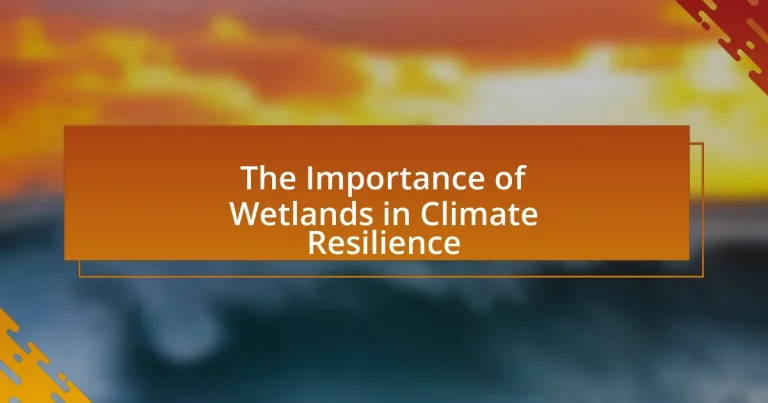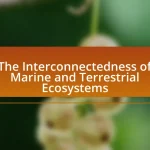Wetlands are vital ecosystems characterized by saturated soils and diverse plant and animal life, playing a crucial role in climate resilience. They function as natural buffers against extreme weather events, sequester significant amounts of carbon, and improve water quality, supporting biodiversity. The article explores the importance of wetlands in flood mitigation, their contributions to climate regulation, and the threats they face from climate change and urban development. It also highlights the benefits of wetland restoration and conservation efforts, emphasizing their role in achieving sustainable development goals and enhancing community resilience.
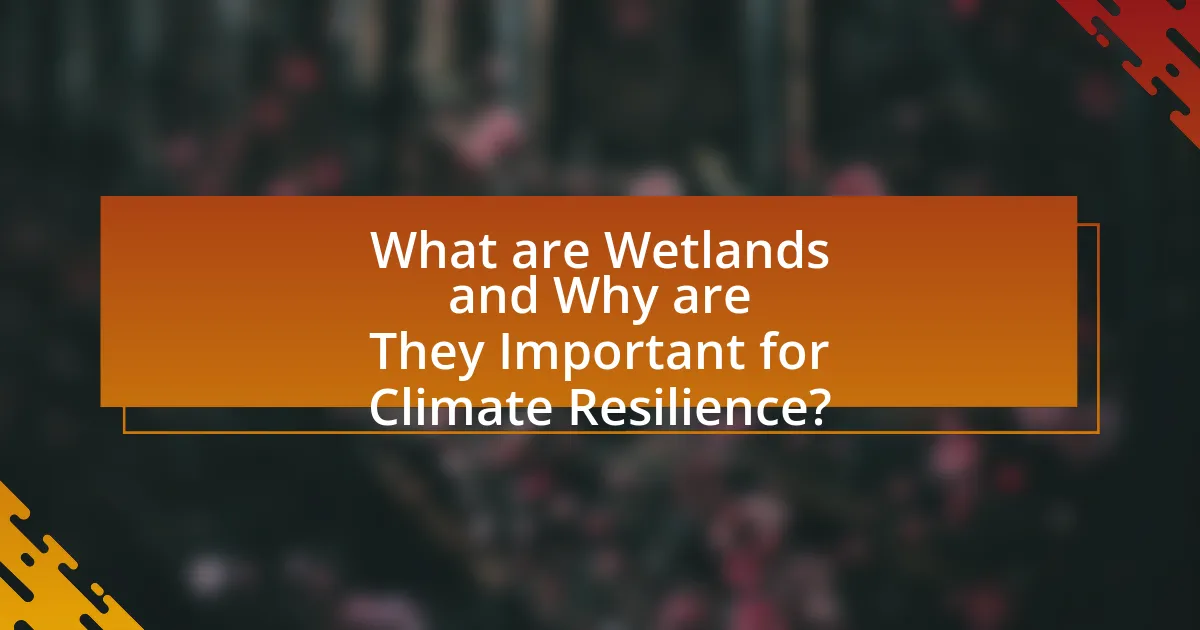
What are Wetlands and Why are They Important for Climate Resilience?
Wetlands are ecosystems characterized by saturated soils and water, supporting diverse plant and animal life. They play a crucial role in climate resilience by acting as natural buffers against extreme weather events, such as floods and storms, by absorbing excess rainfall and reducing runoff. Additionally, wetlands sequester carbon dioxide, helping to mitigate climate change effects; studies indicate that they can store up to 30% of the world’s soil carbon despite covering only about 6% of the Earth’s surface. Their ability to filter pollutants and improve water quality further enhances ecosystem health, making wetlands vital for both biodiversity and climate adaptation strategies.
How do Wetlands Function in the Ecosystem?
Wetlands function as critical ecosystems by providing habitat, water filtration, flood control, and carbon storage. They support diverse plant and animal species, contributing to biodiversity; for instance, wetlands are home to approximately 40% of the world’s plant and animal species despite covering only about 6% of the Earth’s surface. Additionally, wetlands filter pollutants from water, improving water quality and reducing the impact of flooding by absorbing excess rainwater. They also sequester carbon, helping mitigate climate change effects; studies indicate that wetlands can store up to 30% of the world’s soil carbon.
What are the key characteristics of Wetlands?
Wetlands are characterized by their unique hydrology, vegetation, and soil types. They are areas where water is present at or near the surface for a significant part of the year, leading to the development of specialized plant communities adapted to saturated conditions. The soil in wetlands, known as hydric soil, is typically anaerobic and rich in organic matter, which supports diverse ecosystems. Additionally, wetlands serve crucial ecological functions, such as water filtration, flood control, and carbon sequestration, making them vital for climate resilience. Studies indicate that wetlands can store up to 30% of the world’s carbon, highlighting their importance in mitigating climate change impacts.
How do Wetlands contribute to biodiversity?
Wetlands contribute to biodiversity by providing critical habitats for a diverse range of plant and animal species. These ecosystems support approximately 40% of the world’s plant and animal species, despite covering only about 6% of the Earth’s surface. Wetlands serve as breeding grounds, feeding areas, and migratory stopovers for numerous species, including fish, amphibians, birds, and invertebrates. The complex structure of wetland vegetation creates niches that support various life forms, enhancing species richness and ecological interactions. Additionally, wetlands play a vital role in nutrient cycling and water purification, which further supports the health of surrounding ecosystems and contributes to overall biodiversity.
What Role do Wetlands Play in Climate Regulation?
Wetlands play a crucial role in climate regulation by acting as carbon sinks, absorbing and storing carbon dioxide from the atmosphere. This process helps mitigate climate change by reducing greenhouse gas concentrations. According to the Ramsar Convention, wetlands can sequester up to 1.5 billion tons of carbon annually, significantly contributing to global carbon management efforts. Additionally, wetlands regulate local climates by maintaining humidity and influencing precipitation patterns, further supporting climate stability.
How do Wetlands sequester carbon?
Wetlands sequester carbon primarily through the accumulation of organic matter in their waterlogged soils. The anaerobic conditions in wetlands slow down the decomposition of plant material, allowing carbon to be stored in the form of peat and other organic sediments. Research indicates that wetlands can store up to 30% of the world’s soil carbon, despite covering only about 6% of the Earth’s surface. This significant carbon storage capacity is crucial for mitigating climate change, as it helps reduce the amount of carbon dioxide in the atmosphere.
What impact do Wetlands have on local climate conditions?
Wetlands significantly influence local climate conditions by regulating temperature and humidity levels. They act as natural buffers, absorbing excess rainfall and reducing the risk of flooding, which helps maintain stable local climates. Additionally, wetlands sequester carbon dioxide, mitigating greenhouse gas emissions and contributing to climate change resilience. Studies indicate that wetlands can store up to 1.5 billion tons of carbon annually, highlighting their critical role in climate regulation.
Why are Wetlands Critical for Flood Mitigation?
Wetlands are critical for flood mitigation because they act as natural sponges, absorbing excess rainfall and reducing surface runoff. This absorption helps to lower the risk of flooding in surrounding areas. Studies indicate that wetlands can store large volumes of water; for instance, a single acre of wetland can store up to 1 million gallons of water. Additionally, wetlands slow down water flow, allowing for better infiltration into the ground and reducing the peak flow of rivers during heavy rain events. This function is vital in urban areas where impervious surfaces increase flood risks.
How do Wetlands absorb excess rainfall?
Wetlands absorb excess rainfall through their unique hydrological properties, which allow them to store and filter large volumes of water. When heavy rainfall occurs, wetlands act like sponges, capturing runoff and preventing flooding by temporarily holding water in their saturated soils and vegetation. This capacity for water retention is supported by the presence of organic matter and specialized plant species that thrive in wet conditions, which enhance the soil’s ability to absorb and retain moisture. Studies indicate that wetlands can reduce peak flood flows by up to 50%, demonstrating their critical role in managing excess rainfall and mitigating flood risks.
What are the long-term benefits of Wetlands in flood-prone areas?
Wetlands in flood-prone areas provide significant long-term benefits, including flood mitigation, water quality improvement, and biodiversity support. These ecosystems act as natural sponges, absorbing excess rainfall and reducing the severity of flooding events. Research indicates that wetlands can decrease flood peaks by up to 30%, thereby protecting surrounding communities and infrastructure. Additionally, wetlands filter pollutants and sediments from water, enhancing water quality and promoting healthier aquatic ecosystems. They also serve as critical habitats for diverse species, contributing to overall biodiversity and ecosystem resilience. These benefits collectively underscore the vital role wetlands play in enhancing climate resilience in flood-prone regions.
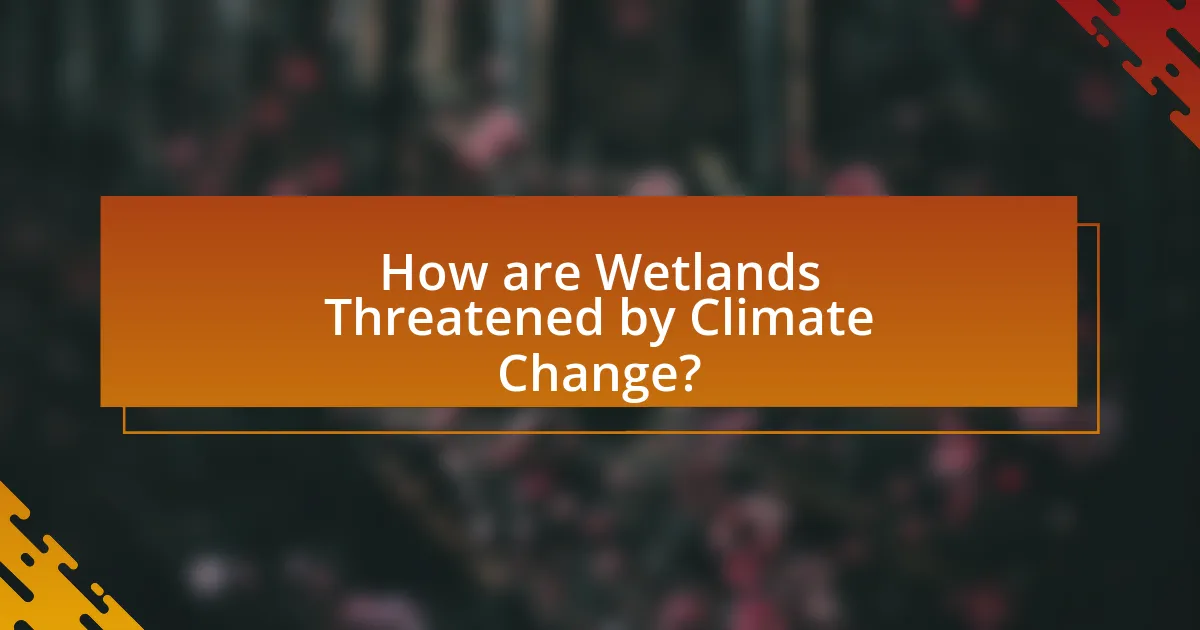
How are Wetlands Threatened by Climate Change?
Wetlands are threatened by climate change primarily through rising sea levels, increased temperatures, and altered precipitation patterns. Rising sea levels inundate coastal wetlands, leading to habitat loss and increased salinity, which can disrupt the delicate balance of these ecosystems. Increased temperatures can exacerbate evaporation rates, reducing water levels and affecting the flora and fauna that depend on these habitats. Additionally, altered precipitation patterns can lead to either flooding or drought, both of which can degrade wetland health and functionality. According to the Intergovernmental Panel on Climate Change (IPCC), these changes can result in significant biodiversity loss and diminished ecosystem services provided by wetlands, such as water filtration and carbon storage.
What are the primary threats to Wetlands?
The primary threats to wetlands include habitat destruction, pollution, invasive species, climate change, and hydrological alterations. Habitat destruction, often due to urban development and agriculture, leads to significant loss of wetland areas; for instance, the United States has lost over 50% of its original wetlands since the 1600s. Pollution from agricultural runoff and industrial discharges degrades water quality, harming aquatic life and disrupting ecosystems. Invasive species can outcompete native flora and fauna, further destabilizing these environments. Climate change impacts wetlands through rising temperatures and altered precipitation patterns, which can lead to increased flooding or drought. Lastly, hydrological alterations, such as dam construction and water diversion, disrupt natural water flow, affecting wetland health and function.
How does rising sea level affect Wetlands?
Rising sea levels negatively impact wetlands by increasing salinity, leading to habitat loss and decreased biodiversity. As sea levels rise, saltwater intrudes into freshwater wetlands, altering the delicate balance of these ecosystems. Research indicates that a one-meter rise in sea level can inundate up to 50% of coastal wetlands, significantly affecting plant and animal species that rely on these habitats for survival. Additionally, the loss of wetlands reduces their ability to act as natural buffers against storm surges and flooding, further compromising coastal resilience.
What role does urban development play in Wetland degradation?
Urban development significantly contributes to wetland degradation by altering natural landscapes, leading to habitat loss and water quality deterioration. The expansion of urban areas often involves draining wetlands for construction, which disrupts the hydrology essential for maintaining wetland ecosystems. According to the U.S. Environmental Protection Agency, urbanization has resulted in the loss of approximately 50% of the nation’s wetlands since the 1800s, highlighting the direct impact of urban development on these critical environments. Additionally, increased impervious surfaces from urban infrastructure lead to higher runoff and pollution, further degrading wetland health and functionality.
How can Wetland Restoration Enhance Climate Resilience?
Wetland restoration enhances climate resilience by improving ecosystem services that mitigate climate impacts. Restored wetlands can absorb excess rainfall, reducing flood risks and enhancing water quality by filtering pollutants. According to the U.S. Environmental Protection Agency, wetlands can store up to 1.5 million gallons of water per acre, which helps in flood control. Additionally, wetlands sequester carbon, with studies indicating that they can store carbon at rates of 0.5 to 1.5 tons per hectare per year, thus contributing to climate change mitigation. By providing habitat for diverse species, restored wetlands also support biodiversity, which is crucial for ecosystem stability in the face of climate change.
What are the best practices for Wetland restoration?
The best practices for wetland restoration include assessing the site conditions, involving stakeholders, and using native plant species. Assessing site conditions ensures that the specific hydrology, soil types, and existing flora and fauna are understood, which is crucial for effective restoration. Involving stakeholders, such as local communities and conservation groups, fosters collaboration and support, enhancing the project’s success. Utilizing native plant species promotes biodiversity and ecological resilience, as these plants are adapted to local conditions and support native wildlife. Research indicates that projects incorporating these practices have higher success rates, with studies showing that native plant restoration can increase biodiversity by up to 50% compared to non-native species.
How does restoration contribute to community resilience?
Restoration contributes to community resilience by enhancing ecosystem services that support social, economic, and environmental stability. For instance, restoring wetlands improves water quality, reduces flooding, and provides habitat for wildlife, which in turn supports local economies reliant on fishing and tourism. Research indicates that communities with restored wetlands experience a 30% reduction in flood damage compared to those without such ecosystems, demonstrating the tangible benefits of restoration efforts. Additionally, restored wetlands can sequester carbon, helping mitigate climate change impacts, which further strengthens community resilience against environmental stressors.
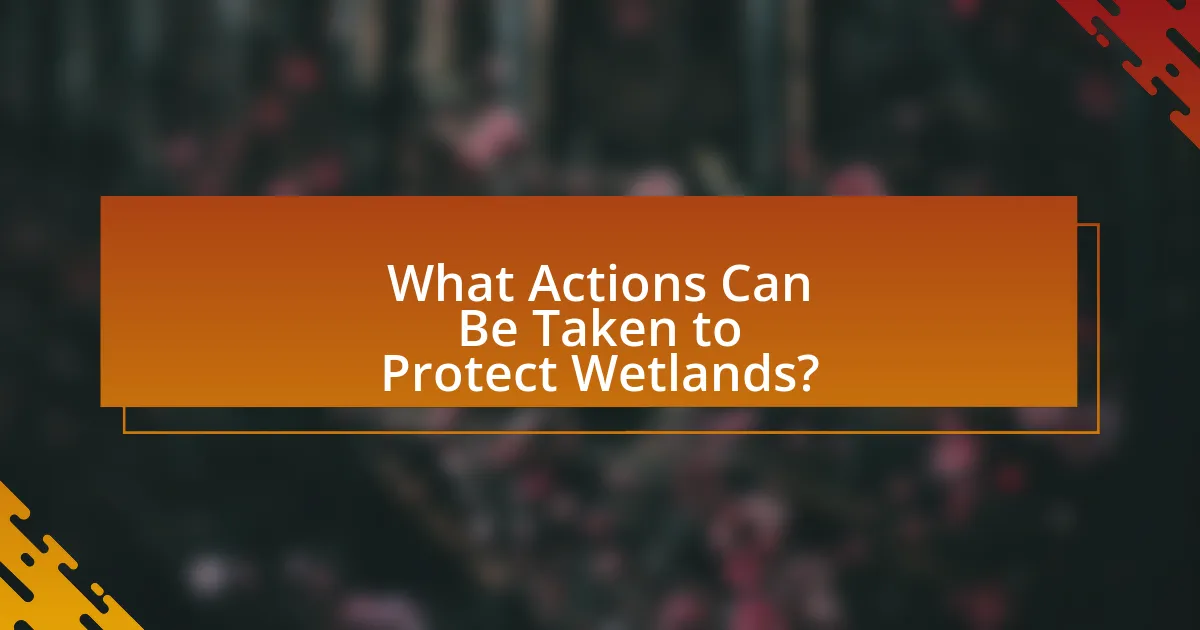
What Actions Can Be Taken to Protect Wetlands?
To protect wetlands, implementing conservation policies and restoring degraded areas are essential actions. Conservation policies can include establishing protected areas, enforcing regulations against pollution, and promoting sustainable land use practices. Restoration efforts may involve replanting native vegetation, removing invasive species, and re-establishing natural hydrology. According to the Ramsar Convention on Wetlands, effective management of wetlands can enhance biodiversity, improve water quality, and mitigate climate change impacts, demonstrating the critical role of these ecosystems in climate resilience.
What policies support Wetland conservation?
Wetland conservation is supported by policies such as the Clean Water Act, the Ramsar Convention on Wetlands, and the National Wetlands Inventory. The Clean Water Act regulates the discharge of pollutants into U.S. waters, thereby protecting wetland ecosystems. The Ramsar Convention, an international treaty, aims to conserve wetlands of international importance, promoting sustainable management and use. The National Wetlands Inventory provides data and maps to inform conservation efforts and policy-making. These policies collectively enhance the protection and restoration of wetlands, which are crucial for climate resilience by providing flood control, water filtration, and habitat for biodiversity.
How can local communities engage in Wetland protection?
Local communities can engage in wetland protection by participating in conservation initiatives, advocating for sustainable land use practices, and educating others about the ecological importance of wetlands. Community-led efforts, such as organizing clean-up events, monitoring local wetland health, and collaborating with environmental organizations, can significantly enhance wetland preservation. For instance, studies show that community involvement in wetland restoration projects can lead to a 30% increase in biodiversity and improved ecosystem services, demonstrating the effectiveness of local engagement in protecting these vital areas.
What are the benefits of preserving Wetlands for future generations?
Preserving wetlands provides critical benefits for future generations, including biodiversity conservation, flood mitigation, and carbon sequestration. Wetlands serve as habitats for numerous species, supporting over 40% of the world’s wildlife, which is essential for maintaining ecological balance. Additionally, wetlands act as natural buffers against floods by absorbing excess rainwater, thereby reducing the risk of flood damage to communities. They also play a significant role in carbon sequestration; studies indicate that wetlands can store up to 30% of the world’s soil carbon, helping to mitigate climate change impacts. These functions underscore the importance of wetlands in promoting environmental health and resilience for future generations.
How do Wetlands support sustainable development goals?
Wetlands support sustainable development goals by providing essential ecosystem services that enhance environmental health, economic stability, and social well-being. They act as natural water filters, improving water quality and reducing pollution, which aligns with Goal 6: Clean Water and Sanitation. Additionally, wetlands store carbon, contributing to climate change mitigation, thus supporting Goal 13: Climate Action. They also provide habitat for biodiversity, which is crucial for Goal 15: Life on Land. Furthermore, wetlands offer resources for livelihoods, such as fisheries and tourism, promoting economic growth and poverty reduction, in line with Goal 8: Decent Work and Economic Growth. The multifunctional nature of wetlands makes them integral to achieving multiple sustainable development goals simultaneously.
What practical steps can individuals take to support Wetland conservation?
Individuals can support wetland conservation by participating in local restoration projects, advocating for policies that protect wetlands, and reducing personal water usage. Engaging in community efforts, such as planting native vegetation or participating in clean-up events, directly contributes to the health of wetland ecosystems. Advocacy for legislation, like the Clean Water Act, helps ensure that wetlands receive necessary protections. Additionally, reducing water consumption through efficient practices lowers the demand on wetland resources, promoting their sustainability. These actions collectively enhance wetland resilience, which is crucial for climate adaptation and biodiversity preservation.
